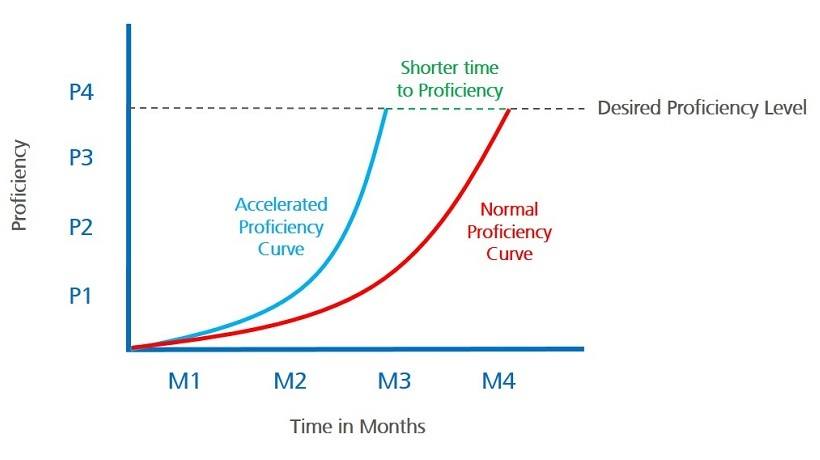How To Accelerate Employees’ Time To Competency
Rolling out a new application? Here are some tips on how to accelerate time to competency for your end-users!
By definition, competence is a collection of related abilities, commitments, knowledge, and skills that enable a person to act effectively in a job or situation.
For organizations, accelerating time to competency is closely linked with accelerating time to ROI; competency effects user productivity, organizational efficiency, and project success. In a world where technology becomes obsolete in the blink of an eye and competitors are more aggressive, every bit of time counts. Those that contribute the most to organizational objectives are those who are better trained and are up to speed to the latest technologies, standards, or procedures.
While managers may want to apply these practices in broad strokes, it can be beneficial to take a more focused approach. Accelerating time to competency requires a plan, commitment, time, and energy. Focusing on solving the right problem is crucial for accelerating time to competence.
To better illustrate why we first need to focus on solving the right problem with a competency plan, we need to understand the Four Stages of Learning developed by Noel Burch in the 1970s:
- Unconscious Incompetence: "I don't know that I don't know."
- Conscious Incompetence: "I know that I don't know how to do this, yet."
- Conscious Competence: "I know that I know how to do this."
- Unconscious Competence: "Did I do something well?"
While not all individuals will start at the same phase, it is important that managers provide appropriate resources to aid all end users in working through this process based on individual needs.
According to Ericsson, Krampe & Tesch-Romer (1993), it takes 10,000 hours or 10-years of intense training and “deliberate practice” to become an expert in almost anything. In the business world, 10 years may not be accessible for everyone, however “deliberate practice” is; simply stated – competence requires practice. If managers really want to accelerate time to competence, designing and developing a training program with consistent and measurable practice throughout is key. In the world of training, practice can be defined as any activity that requires the application of knowledge, with the applied interaction of end users.
4 Training Methods For Accelerating Time To Competency
The following are some examples of common training methods, and how managers can utilize these methods to guide end users through the Four Stages of Learning:
1. eLearning.
eLearning is an excellent option to support both the first and second phases of learning. Given the flexibility of eLearning, content can be catered to support the learning process of someone who is in the incompetence stages by offering basic conceptual information that will make them transition from the unawareness to the awareness stage. Also, eLearning can accommodate different learning styles, be deployed to a large number of people, and can be complemented with practical exercises to prepare users for the skill development phase.
2. Localized Training.
Even multilingual companies should think twice about localizing training content. Having multilingual employees is not a guaranty for seamlessly content assimilation. Localized training* content not only affects time to proficiency, but also affects return on investment, as it helps users to reduce the time it takes to assimilate information, minimizes training time, and improves information retention. In early stages of learning, as Conscious Incompetence where users are prone to resist change, localized content, more often than not, can accelerate adoption.
As every project faces budget restrictions, be careful when choosing what not to localize. Remember that localization doesn’t only refer to language translation, but also refers to preservation of instructional intent and adaptation to the local context.
3. In-Application Support.
Implementing a new ERP or upgrading from one version to another is a business decision often made for the purpose of improving business efficiency. However increased efficiency with a new system is not guaranteed. Many ERP implementations fail or take longer than expected to deliver desired results. This is often due to poor on the job assistance. Many tools used for training content development offer context sensitive in-application support that guide the user through the steps they need to perform. In a stage of Conscious Competence where users know how to perform a certain task, however a strong mental focus and commitment to the task is required, guidance within the application is better suited to provide non obtrusive assistance only when needed, resulting in better business results, but more importantly, resulting improved confidence and fearless repetition of the task, which will ultimately lead to mastery.
4. Coaching.
Once mastery has been reached and tasks are performed naturally without too much effort, one could say Unconscious Competence has been reached. Take advantage of those who have reached this level and encourage them to coach others. Coaching has the potential to leverage the time to proficiency curve. Having someone by your side backing up, guiding and encouraging makes you go that extra step, therefore embrace change and reach competence faster.
Final Thoughts
As a final step, it’s important to measure how our actions influenced the proficiency curve. The old adage "you can’t manage what you don’t measure" holds true when determining the impact of actions taken to improve the proficiency curve. As techniques are implemented, evaluate each of them to establish which works the best for your organization and make the necessary adjustments. Remember that the underlying topic is ROI, therefore pay attention to which action is performing best and represents more value.
Establish the amount of time someone regularly takes to be fully proficient at their role or any specific task and compare that measurement with the results obtained after implementing any of the strategies to accelerate the time to competence.
Be creative about how to blend all these different training approaches, but always keep in mind that practice makes perfect.

